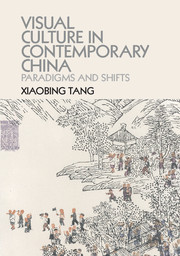Book contents
- Frontmatter
- Contents
- Acknowledgments
- A brief timeline of relevant events
- Introduction Toward a short history of visual culture in contemporary China
- Chapter 1 How was socialist visual culture created?
- Chapter 2 How was socialist visual culture created?
- Chapter 3 What do we see in New China cinema?
- Chapter 4 What does socialist visual experience mean to contemporary art?
- Chapter 5 How (not) to watch a Chinese blockbuster
- Chapter 6 Where to look for art in contemporary China
- Conclusion Seeing China from afar
- Glossary
- List of Illustrations
- Filmography
- Select bibliography
- Index
- References
Chapter 2 - How was socialist visual culture created?
Part II: Revelations of a history painting
Published online by Cambridge University Press: 05 January 2015
- Frontmatter
- Contents
- Acknowledgments
- A brief timeline of relevant events
- Introduction Toward a short history of visual culture in contemporary China
- Chapter 1 How was socialist visual culture created?
- Chapter 2 How was socialist visual culture created?
- Chapter 3 What do we see in New China cinema?
- Chapter 4 What does socialist visual experience mean to contemporary art?
- Chapter 5 How (not) to watch a Chinese blockbuster
- Chapter 6 Where to look for art in contemporary China
- Conclusion Seeing China from afar
- Glossary
- List of Illustrations
- Filmography
- Select bibliography
- Index
- References
Summary
Upon entering the National Museum of China (NMC), a colossal architectural complex on the east side of Tiananmen Square in the heart of Beijing, we may easily find ourselves dwarfed and disoriented by the vast vaulting space and soaring escalators. On any given day, the reportedly largest museum space in the world may support a busy overlapping schedule of exhibitions, lectures, screenings, and performances with its forty-eight galleries and other state-of-the-art facilities. Formed in 2003 from a merger of two modern institutions – the Museum of Chinese History and the Museum of the Chinese Revolution – the NMC commands tremendous resources and takes as one of its mandates to integrate presentations of the revolutionary twentieth century with those of the much longer history of Chinese civilization. The desire for a coherent grand narrative is best reflected in two permanent exhibitions, Ancient China and The Road to Rejuvenation, which the prestigious institution introduced in early 2011, when it reopened after undergoing renovations that lasted three years.
In June 2011, in celebration of the ninetieth anniversary of the Chinese Communist Party, the NMC drew from its rich collections and installed in the most prominent Central Hall another regular exhibition, Masterpieces of Modern Chinese Art. All but one work, created by prominent artists between 1951 and 1972 and mostly under the auspices of the former Museum of the Chinese Revolution, deal with pivotal episodes or figures in the revolutionary twentieth century.
- Type
- Chapter
- Information
- Visual Culture in Contemporary ChinaParadigms and Shifts, pp. 61 - 101Publisher: Cambridge University PressPrint publication year: 2015



